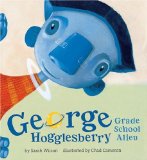In my ongoing search for picture books about plays, I can’t believe I forgot an old favorite, Amazing Grace by Mary Hoffman and Caroline Binch. Grace is a young girl who loves to act out stories. The illustrations of her pretending to be all sorts of characters are beautiful and inventive, and you can see what play items she has pulled into her pretend stories: teddies as jungle animals, stockings as spider webs, a card board box for a horse. She turns the world into her own adventure.
When her teacher announces they will perform Peter Pan, Grace wants to play Peter. Her classmates tell her she can’t. First of all, she’s not a boy, and second, she’s black and Peter isn’t. Her Ma and Nana are supportive, though, and tell her she can be anything she wants. The story includes a trip to see a black ballerina playing Juliet on stage. In the end, Grace does play Peter, and not just because her teacher casts her, but because her classmates vote for her to play the role. She’s proven she can play Peter regardless of her skin color and gender.
This is an extremely important concept in PictureBook Plays: children can make their own choices about their own characters. It is okay
- For girls to be pirates with scratchy beards
- For boys to wear tutus and tiaras
- For girls to be grandpas
- For boys to be mamas.
- For dark-skinned children to be white historical figures.
- For light-skinned children to be dark-skinned historical figures.
Educational Theatre, and especially PictureBook Plays, is about using your imagination to explore what you are not, even something simple, like my three year old daughter telling me the other day that she was pretending to be a Big Girl, and therefore started calling me “Mother†rather than Mama. In her world, Big Girls say “Mother.â€Â It was not my place to “correct,†it was my place to respond as Mother and allow her to explore this new world as she saw fit.
Grace has a big imagination, a supportive family, and bravery. This is a terrific book to have in the classroom not just on Drama days.

